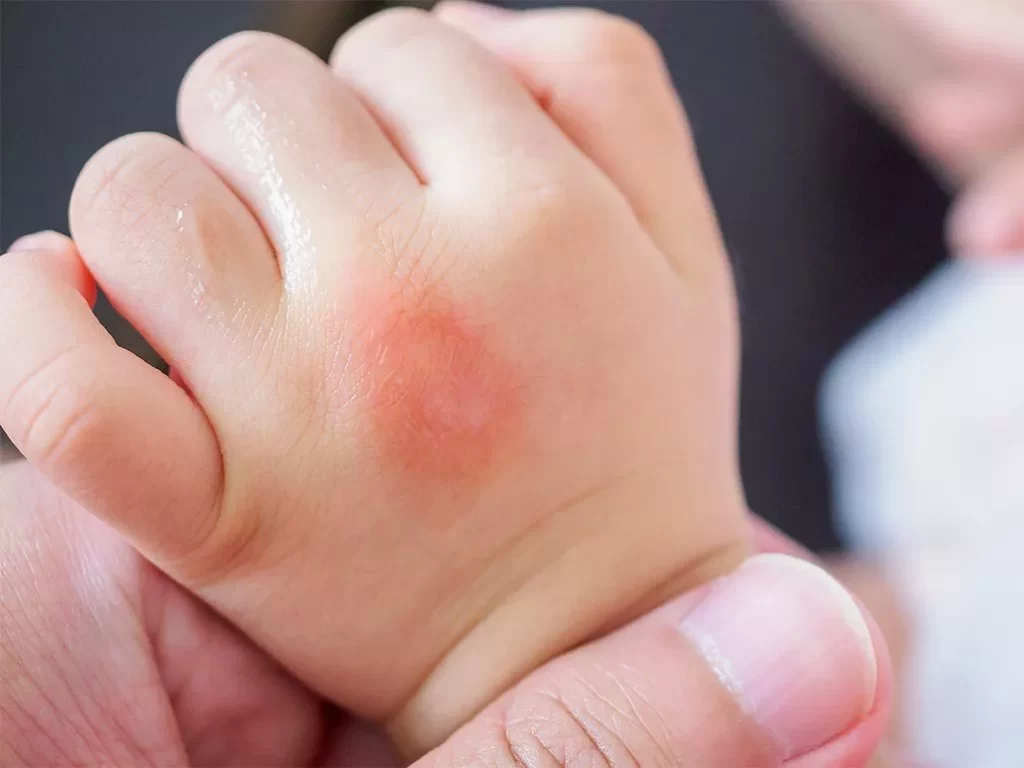Bees, those buzzing insects that diligently pollinate our flowers and crops, are often revered for their crucial role in maintaining the delicate balance of nature. However, their stinging reputation also precedes them. When threatened, bees unleash their defense mechanism in the form of a sharp sting, accompanied by the release of venom.

The result can be an experience ranging from a mild annoyance to a severe allergic reaction. In this article, we will explore the science behind bee stings, shedding light on the pain and reactions associated with these encounters. By understanding the complexities of bee stings, we can develop a deeper appreciation for these remarkable creatures and learn how to coexist with them safely.
How Bad Do Bee Stings Hurt?
Bee stings can evoke a wide range of pain experiences depending on the individual’s pain tolerance and sensitivity. Some people may encounter an instant, sharp, and burning pain similar to cramps, while others may initially not feel much pain until the venom starts to take effect and the area begins to swell. The intensity of the pain can also be influenced by factors such as the location of the sting and the number of stings received.
The Intensity of Pain: A Personal Experience
Understanding the intensity of pain from bee stings is often subjective, as pain perception varies from person to person. For some individuals, a bee sting might be a minor nuisance, causing minimal discomfort, while for others, it can be an excruciating experience. Factors like age, overall health, and prior exposure to bee stings can influence an individual’s pain response. It is essential to remember that bee stings are a form of defense mechanism for bees, and they don’t sting humans unless they feel threatened.
Unraveling the Reactions: Mild, Moderate, and Severe
Bee sting reactions can be categorized into three levels: mild, moderate, and severe. Understanding these reactions can provide insight into the body’s complex response to a bee sting.
Mild Reaction
Contrary to popular belief, a significant number of people experience only a mild reaction to bee stings. A mild reaction typically includes immediate pain followed by a sharp burning sensation at the sting site. There may be minor swelling around the affected area and a red welt. In most cases, these mild symptoms subside within a few hours, and the individual can resume their normal activities without major discomfort.
Moderate Reaction
In cases of a moderate reaction to a bee sting, the pain intensifies, and symptoms become more pronounced. Individuals may experience immediate, intense pain upon being stung, and the swelling may progressively enlarge over a few days, causing discomfort in the entire affected area. Noticeable redness around the sting site is also common. Moderate reactions may take longer to resolve, with symptoms lasting between five to ten days. If an individual repeatedly experiences moderate to severe reactions to bee stings, seeking medical advice is crucial.
Severe Reaction: Anaphylactic Shock
At the severe end of the spectrum lies anaphylactic shock, a life-threatening condition that demands immediate medical attention. Symptoms of anaphylactic shock include severe skin reactions, such as hives and itching, flushed or pale skin, swelling of the throat and tongue leading to difficulty breathing, gastrointestinal symptoms like diarrhea, nausea, or vomiting, weak and rapid pulse, dizziness, fainting, and, in extreme cases, loss of consciousness. Experiencing a severe reaction to a bee sting increases the risk of anaphylaxis by 30 to 60 percent with subsequent stings. Individuals who are prone to severe reactions should have an emergency kit with prescribed medications like antihistamines, cortisone, and adrenaline to alleviate allergic reactions and stabilize circulation in case of a sting.
The Venomous Truth: Unpacking Bee Venom and Its Effects
When a bee stings, it injects venom into its victim, comprising a mix of proteins, including melittin. Bee venom profoundly affects the immune system and skin cells, leading to swelling and redness. Melittin, in particular, directly stimulates the body’s pain receptors, causing the characteristic burning pain associated with a bee sting. Additionally, melittin disrupts cell membranes, leading to cell damage. Intriguingly, honeybee venom contains anticoagulant properties that have been studied for their potential impact on blood clotting.
A Sting of Difference: Honeybees vs. Bumblebees
Although honeybees and bumblebees might seem similar at first glance, their stinging behavior and consequences differ significantly.
Honeybees: Barbed Stingers with a Fatal Sting
Honeybees possess barbed stingers that remain embedded in the victim’s skin upon stinging. When a honeybee stings a human or other soft-skinned mammals, the stinger becomes lodged and detaches from the bee as it attempts to fly away. This causes the bee to lose its stinger and vital internal organs, leading to its eventual death. The honeybee’s stinging mechanism is a remarkable example of a defense mechanism with fatal consequences for the bee itself.

Bumblebees: Smooth Stingers with Multiple Shots
In contrast, bumblebees have smooth stingers that allow them to sting multiple times without injury. While bumblebees may sting when threatened, they are generally less aggressive compared to honeybees. Due to their smooth stingers, bumblebees can sting and withdraw the stinger without harm, allowing them to sting repeatedly if necessary.
The Aftermath: What to Do When Stung
If you find yourself stung by a bee, quick and proper action can help alleviate pain and potential complications.
Remove the Stinger Properly
The first step is to remove the stinger as soon as possible to minimize venom release. Using your fingernails or a flat object, gently scrape the stinger off the skin. Avoid using tweezers, as they can inadvertently squeeze more venom into the wound.
Clean and Soothe the Sting Site
After removing the stinger, wash the affected area with cold, soapy water to remove any venom residue. Applying something cold, such as an ice pack or a cold compress, can help reduce swelling and soothe the pain. Over-the-counter antihistamines can also help counteract allergic reactions.
Monitor Swelling and Seek Medical Attention
Keep an eye on the swelling around the sting site. If the swelling worsens or spreads to other areas, seek medical attention promptly. Some individuals find it helpful to draw a circle around the sting site to monitor changes. Those with known allergies to bee stings should always carry emergency medications prescribed by a doctor to manage severe reactions.
A Unique Weapon: The Queen Bee’s Sting
Unlike worker bees, the queen bee’s stinger serves a completely different purpose. The queen’s stinger is larger and smoother than that of worker bees, and she uses it solely for breeding purposes. The queen bee uses her stinger to lay thousands of eggs throughout her life, ensuring the hive’s continuity. However, as her reproductive abilities wane, she leaves the hive, paving the way for her successor.
Understanding Schmidt’s Insect Sting Pain Index in North America
Have you ever wondered how insects like wasps, bees, and ants are capable of delivering such potent stings? The bullet ant has gained notoriety for its excruciating sting, often described as a piercing, stabbing pain, and it’s regarded as one of the most intense experiences on the insect sting pain index. However, what about other insects? In this article, we delve into the realm of stinging insects through the lens of entomologist Justin Schmidt’s pain index, unveiling the mysteries surrounding diverse insect stings and their varying levels of discomfort.
Schmidt’s Pain Index and Its Significance
Schmidt’s Pain Index for insect stings offers valuable insights into the pain caused by different insects. Its classification categorizes insect stings into five distinct levels, with the bullet ant, as mentioned earlier, occupying a prominent position on the scale. This index aids scientists and entomologists in better comprehending the physiological and chemical aspects of these stings.
For more details on Schmidt’s Insect Sting Pain Index and how the bullet ant compares to other stings, visit this page.
The Tragedy of a Sting: Why Bees Die After Stinging
The notion that bees die after stinging humans is not entirely true. Bees can defend themselves without dying when they sting other insects with rigid exoskeletons. However, when a bee stings a human or other soft-skinned mammals, its barbed stinger becomes lodged in the skin, causing the stinger and vital internal organs to detach from the bee. This results in the bee’s demise, making it a sacrificial act in defense of the hive.
By delving into the science behind bee stings, we gain a deeper appreciation for these incredible creatures and the complexities of their defense mechanisms. Bees play a crucial role in pollination and the ecosystem, making their survival essential for maintaining biodiversity.
Frequently Asked Questions (FAQ) About Bee Stings
Q: How bad do bee stings hurt?
A: Bee stings can evoke varying degrees of pain, depending on an individual’s pain tolerance and sensitivity. Some may experience an instant, sharp, and burning pain, while others may initially feel little discomfort, which later escalates due to the venom’s effect and swelling. The intensity of pain can be influenced by factors such as sting location and the number of stings received.
Q: Are bee stings dangerous?
A: For most people, bee stings are not dangerous and result in mild reactions, including pain, swelling, and a red welt, which typically subside within a few hours. However, for individuals with severe allergic reactions, bee stings can be life-threatening and lead to anaphylactic shock. It is crucial to seek immediate medical attention for severe reactions.
Q: What are the different types of bee sting reactions?
A: Bee sting reactions are generally categorized into three levels: mild, moderate, and severe. Mild reactions involve localized pain and swelling that typically resolve within a few hours. Moderate reactions are more pronounced and can last for several days. Severe reactions, known as anaphylactic shock, are life-threatening and require immediate medical intervention.
Q: Can bee stings be treated at home?
A: Mild reactions to bee stings can often be managed at home. It is essential to promptly remove the stinger, clean the affected area with cold, soapy water, and apply a cold compress to reduce swelling. Over-the-counter antihistamines can help alleviate itching and discomfort. However, for individuals with known allergies or severe reactions, seeking medical attention is crucial.
Q: Do all bees die after stinging?
A: Honeybees, with their barbed stingers, die after stinging soft-skinned mammals like humans because the stinger becomes lodged in the skin and detaches from the bee as it tries to fly away, leading to the bee’s demise. However, some bees, like bumblebees, have smooth stingers and can sting multiple times without dying.
Q: How can I avoid getting stung by bees?
A: To avoid bee stings, it is essential to remain calm and avoid swatting at bees. Wear light-colored clothing and avoid wearing strong floral scents, as they can attract bees. Keep food and sweet beverages covered when outdoors, and be cautious when near beehives or areas where bees are active. If you encounter a bee, slowly and calmly move away from it.
Q: Are all bee stings painful?
A: The intensity of pain from a bee sting varies from person to person. While some may find it only mildly uncomfortable, others may experience significant pain. It is essential to remember that bees typically sting as a defense mechanism and do so when they feel threatened.
Q: Can I develop an allergy to bee stings over time?
A: Yes, it is possible for individuals to develop an allergy to bee stings over time. If you experience increasingly severe reactions to bee stings with repeated exposures, it is essential to consult a medical professional for proper evaluation and management.
Q: Why are bees important despite their stinging behavior?
A: Bees play a vital role in pollination, which is essential for the reproduction of many flowering plants and the production of fruits and seeds. They are crucial for maintaining biodiversity and ecosystem balance. Despite their stinging behavior, bees contribute significantly to the environment and agriculture.
Conclusion
Bee stings, while often feared for their painful consequences, are an essential aspect of bees’ defense mechanism. Understanding the science behind bee stings allows us to appreciate the intricacies of these insects and their crucial role in pollination and ecosystem balance. By taking appropriate precautions and knowing how to respond to bee stings, we can foster a safer and more harmonious coexistence with these remarkable creatures. Through increased awareness and respect for bees and their stinging behavior, we can contribute to their survival and the preservation of biodiversity for generations to come.

